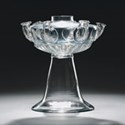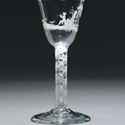In both cases they made up sizeable slices around a third of the content of these events.
Bonhams featured 176 lots of English glass, and of this 80 per cent was given over to one property, the second installment of the Henry Fox collection (part one was sold in the same rooms in June). This was a highly regarded collection assembled by a well-known member of The Glass Circle and offered a representative selection of 18th and early 19th century drinking glasses and associated wares peppered with some unusual variants realistically estimated.
Sotheby's Olympia offered 139 lots of glass, which also made up a third of their sale. This was divided roughly 50/50 on an English and Continental basis and the English section also incorporated a smaller single-owner property, the Pullen collection of drinking glasses. This was an inherited property, the bulk of which was formed some time ago, but with additions made by the consigner more recently.
It wasn't just volume that boosted performance, this was also the right type of material for the market.
English 18th century drinking glasses are one of the steadier sections of the glass market buoyed up by a strong buying base and some new collecting blood. Or as Sotheby's specialist Simon Cottle put it: "English 18th century wine glasses have improved immensely over the past five years or so."
The results last month bore this out.
Bonhams' all-English sale with its provenanced collection gave the clearest illustration. Only 21 lots failed to find a buyer, an 89 per cent take-up. Sotheby's saw a similar, 80 per cent, take-up for the English section of their sale, with all but 14 of the 64 lots changing hands. It also afforded the opportunity to contrast the home-grown strength with the weaker performance of the Continental market where the take-up was a less creditable 50 per cent. Paperweights, a separate collecting field also in demand, fared well here too, with just two of the 13 lots left unsold.
And it wasn't just a case of high selling rates: demand is strong enough to ensure that the rare or unusual entries were pursued to strong levels.
At Bonhams those rarities included a particularly attractive Beilby enamelled wine glass whose decoration of a shepherd piping in a pastoral landscape was unusual enough to lift it beyond the realms of the ordinary (if any Beilby glass can be counted as ordinary). A similar example is illustrated in the collectors glass 'bible', Bickerton's 18th century English Drinking Glasses, while Sotheby's sold another version two years ago for £13,000. Bonhams' example was taken to £13,500.
An earlier Fox rarity was the rare and large 10 1/2in (27cm) high six-nozzled lamp of c.1690-1700 pictured here. Ex the Keith Kelsall collection, this much-exhibited and published piece fetched £9800 bought once again by Mallett, this time on behalf of a client.
Early baluster glasses, especially ones with unusual stem formations, have long been the glass collector's holy grail. At Bonhams these included a good 6in (15cm) high example of c.1720 with a stem consisting entirely of knops, which fetched £4200, and a slightly larger wine glass of the same period, with an annulated six-knop stem, that realised £4400.
The Pullen collection had a higher proportion of more standard fare and a disproportionately high focus on Dutch engraved light balusters, but reasonably estimates helped secure a strong selling rate. There were also one or two collectable rarities like the desirable colour twist, of c. 1765, a 5 3/4in (15cm) high model with translucent green and blue threads enclosing a central white core that was carried off by a Swiss collector at £4500.
And lifted out of the ordinary by unusual engraving was the 6in (15.5cm) high opaque twist wine of c.1761 with the electioneering slogan Lowther and Upton Huzza to the bowl, which made £2600.
In the Continental section of Sotheby's sale the most difficult area continues to be Germanic and 19th century middle European glass. The façon-de-Venise, which has held up better, true to form enjoyed a higher strike rate. Simon Cottle also noted that the Japanese buyers, who have been making renewed appearance, were active in the 19th century and Cameo glass.
Sotheby's also included 22 lots of potentially more expensive material in their higher-end Bond Street sale offered two weeks earlier on December 2. Around half of this found buyers, led at £22,000 by a Lobmeyer two-handled vase of c.1875 decorated in Persian style with gilding and green and white enamelling. A rare Hall in Tirol façon de Venise tazza of c.1580 was also sought after, doubling estimate when the Austrian trade paid £18,000 to secure it.
Top English piece was a 6 1/4in (16cm) high opaque twist privateer glass, engraved to the bowl with a sailing ship and the legend Success to the Eagle Frigate, Privateer and Benjamin Huntley 1757. The only known glass dedicated to this ship, it was taken to £15,000, comfortably over estimate, by one of those welcome new buyers.
English drinking glasses remain toast of market
Two of the strongest performances in the December ceramics sales came from the glass sections offered at Bonhams Bond Street on December 8 and at Sotheby’s Olympia two weeks later.








